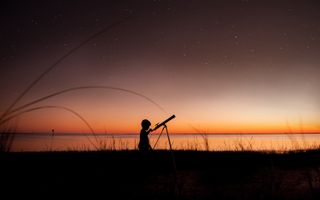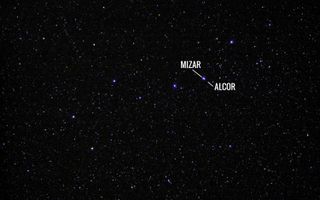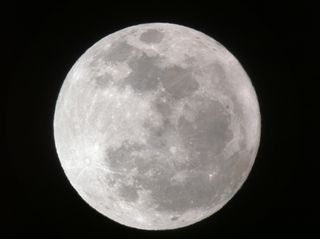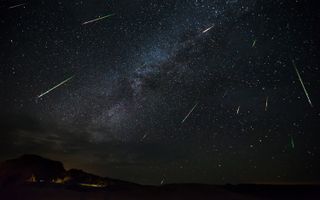Night Sky Events to Show Your Kids in Summer 2018

There are a lot of things going on in that wondrous sky above our heads. One way to get kids interested in astronomy is to show them some "gee-whiz" objects that are not only fun to look at, but can even test their perception and vision. Here are just a few things you can show them in the summer night skies of 2018.
Mizar and Alcor: The eye test
Check out the middle star in the handle of the Big Dipper, which on summer evenings can be found high in the northwest part of the sky. That particular star is Mizar, and immediately above and slightly to the left of it is a fainter star known as Alcor. These two stars form a pair popularly called "the horse and rider" and are traditionally considered to be a good test for the naked eye.

Back in the 14th century, the Arabian writer Al-Firuzabadi referred to Mizar and Alcor as "the test" or "the riddle," while in the 13th century, the Persian writer Al- Qazwini stated that "people tested their eyesight by this star." Tell your child to look at the Dipper's seven stars and ask if any of them look unusual. If he or she says that the middle star in the Dipper's handle seems to be composed of two stars and not just one, your kid probably has good eyesight and is rather perceptive.
A very young moon
What is the thinnest moon that you have ever seen? On Friday evening (July 13), travel to a location where you will have a clear and unobstructed view of the west-northwest horizon. Try to make it a sea shore or perhaps a hill or tall building where you can look out over everything. If you have binoculars, bring them along; they may help you sight your quarry.
You will be looking for a moon that is less than 24 hours old — a moon that is less than one day after the new moon phase. Most of us have seen a crescent moon in the evening sky, but very likely the moon you sighted came at least two or three days after new phase. The moon you will be looking for on July 13 will be exceedingly slim; just 1 percent of the moon will be illuminated by the sun.

Making a sighting of so slim a moon will be tough, because the twilight sky will be rather bright and the moon itself will be very low near the horizon. Here is the best way to try and find it. About 20 minutes after the sun sets, find Venus, which will be about one-quarter up in the western sky. Now, make a fist and hold it out at arm's length; an adult fist has a width of about 10 degrees. Now, go "three fists" down to the lower right of Venus . . . you'll be almost at the horizon. Now, slowly scan just above the horizon for the skinny sliver of moon.
If you find it in binoculars, see if you can glimpse it with just your eyes. However you sight it, doing so will be quite a feat. Don't be too upset if you don't find it, because seeing such a thin crescent moon is difficult even for experienced sky gazers. [How to Measure Distances in the Night Sky]
Get the Space.com Newsletter
Breaking space news, the latest updates on rocket launches, skywatching events and more!
A young moon with a bonus
The very next evening (Saturday, July 14), sighting the crescent moon will be much easier. Just look low toward the western horizon about 45 minutes after sunset to catch a glimpse of a slender crescent moon, now 5 percent illuminated. And hovering just below it will be a bonus: the planet Mercury. Point out this relatively bright "star" to your child and explain that in reality what they are looking at is the smallest and nearest planet to the sun. Binoculars, of course, will help.
A "mini" moon
On Friday, July 27, we will have a full moon nearly coinciding with apogee, its farthest point from Earth. Point this out to your child. Will both of you notice the moon's rather small size? Because it will be near maximum distance from the Earth when full, the moon will also be traveling relatively slowly in its orbit, and the illumination angle of reflected sunlight falling on its surface will also be changing more slowly. So, even though almanacs and calendars will advertise that the moon is full on that Friday evening, to many, the moon will appear "full" for three nights in a row: on Thursday, the 26th; Friday, the 27th; and Saturday, the 28th.
Indeed, the dark portion near the moon's edge will be very slight on the evenings before and after July 27. An interesting project would be to try and sight a "perfect" full moon, one that shows a truly round disk. Such a moon can always be found just before and after a lunar eclipse, because the moon is then almost directly opposite to the sun.
And guess what? On the afternoon of Friday, July 27, the moon will undergo the longest total lunar eclipse of the century. Unfortunately, by the time the moon rises here in the U.S., the eclipse will have ended (Europe and Asia will get great views), but it still should appear perfectly round that evening. In a sense, this is the opposite of trying to see as thin a lunar crescent as possible; only here we're looking for the thinnest crescent of darkness, which makes the moon appear ever-so-slightly "out of round."
Moon and a bright planet
It's always easy to positively identify a planet when the moon is nearby, and a number of such conjunctions will happen this summer. Here is the complete list:
July 15 – This evening, the 3.5-day-old crescent moon will sit just to the right of Venus.
July 20 – The planet Jupiter will be prominently placed below the moon this evening.
July 24 – As the waxing gibbous moon ascends the south-southeast sky this evening, take note of Saturn shining below it.
Aug. 14 – A 4-day-old crescent moon will be poised high above Venus after sunset this evening.
Aug. 17 – Jupiter will be situated a good distance to the lower right of the moon.
Aug. 20 – As darkness falls, look for Saturn well to the lower left of a 75 percent illuminated gibbous moon.
Aug. 22 – An even wider gibbous moon can be found tonight sailing far above Mars, which dominates the sky east of Saturn. All through this summer, Mars will appear very bright and fiery, because it is making its closest approach to Earth in 15 years.
Sept. 13 – The 4.5-day-old crescent moon will pass well to the upper right of Jupiter in this evening's sky.
Sept. 17 – The 60-percent-illuminated waxing gibbous moon will be found to the upper left of Saturn this evening.
Sept. 19 – A somewhat wider gibbous moon will be found well to the upper right of Mars this evening.

Perseid meteors
This most famous of all meteor showers is expected to reach its peak late at night on Sunday, Aug. 12, into the early morning hours of Monday, Aug. 13. The Perseid meteor shower never fails to provide an impressive display, and due to its summertime appearance, it tends to provide the majority of meteors seen by families and campers. These meteoroids are no bigger than pebbles, have the consistency of cigar ash and burn up in Earth's atmosphere many miles above our heads. They're fast and bright, and they frequently leave persistent trains.
Best views will come from midnight late Saturday night on until the first light of dawn. Far from bright lights and tall obstructions, a single observer looking overhead and toward the northeast may see up to 90 shooting stars per hour. Get some friends with lounge chairs. Arrange the audience radially, heads together. Record the "oohs" and "ahhs" when flashes are seen streaking from the common radiant in Perseus.
This will be a great year to watch for these meteor because the moon will be new, so no bright moonlight will interfere with viewing. [Perseid Meteor Shower 2018: When, Where & How to See It]

Spot the space station!
Lastly, why not show your child a vehicle actually cruising in Earth orbit: the International Space Station (ISS). Those who are looking up from 45 to 90 minutes after sunset or 45 to 90 minutes before sunrise have no doubt noticed a few "moving stars" apparently shifting to another section of the sky. These are artificial satellites, visible to the naked eye by virtue of reflected sunlight.
If you go out and carefully study the sky on any night near dusk or dawn, you likely won't have to wait more than 15 minutes before you see one of the more than 18,000 objects now orbiting the Earth. Most are too faint to view with the naked eye, but a few hundred are large enough (over 20 feet, or 6 meters, in length) and low enough (100 to 400 miles, or 160 to 640 kilometers, above Earth) to be seen. By far the largest is the ISS, which can take up to 6 minutes to move across the sky and can shine with the brightness of Jupiter or even Venus! For kids, it's always an exciting thing to see.

This summer, the ISS will be visible in the predawn sky during the first three weeks of July, then in the evening sky through the rest of July into the first week of August. You can track the ISS and other satellites with this tracking tool on Space.com, or you can generate a specific schedule for your town or city at any of these three websites:
NASA/Spot the Station: https://spotthestation.nasa.gov/sightings/
Heavens Above: https://www.heavens-above.com/
Real Time Satellite Tracking/N2YO.com: http://www.n2yo.com/?s=25544
Joe Rao serves as an instructor and guest lecturer at New York's Hayden Planetarium. He writes about astronomy for Natural History magazine, the Farmers' Almanac and other publications, and he is also an on-camera meteorologist for Fios1 News in Rye Brook, N.Y.Follow us @Spacedotcom, Facebook and Google+. Original article on Space.com.
Join our Space Forums to keep talking space on the latest missions, night sky and more! And if you have a news tip, correction or comment, let us know at: community@space.com.

Joe Rao is Space.com's skywatching columnist, as well as a veteran meteorologist and eclipse chaser who also serves as an instructor and guest lecturer at New York's Hayden Planetarium. He writes about astronomy for Natural History magazine, the Farmers' Almanac and other publications. Joe is an 8-time Emmy-nominated meteorologist who served the Putnam Valley region of New York for over 21 years. You can find him on Twitter and YouTube tracking lunar and solar eclipses, meteor showers and more. To find out Joe's latest project, visit him on Twitter.
